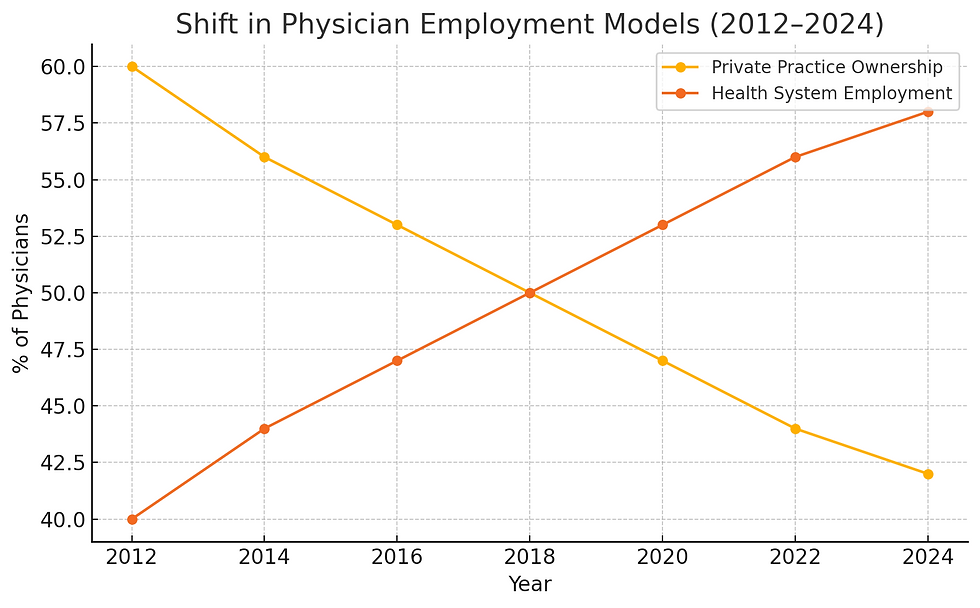Your Billing Team Is Drowning — Signs It’s Time to Rebuild Your RCM Workflow
- Alex.Nedzelskiy@sloanmed

- Jul 30
- 4 min read

If your billing department feels like it’s treading water — constantly reacting, never catching up — you’re not alone. Across private practices, billing teams are stretched thin, systems are outdated, and AR is ballooning. Yet too many providers stay stuck in survival mode, hoping things will just "level out." Spoiler: they won’t.
It’s time to stop putting out fires and start fixing the foundation. Here are the red flags that your billing operation isn’t just overwhelmed — it’s broken. And what you can do to rebuild it into something lean, effective, and profitable.
Over the past five years, denial rates in private practice have steadily climbed—creating a growing bottleneck across billing operations. Data from Kaiser Family Foundation (KFF) shows that in 2023, nearly 19% of in-network claims from ACA Marketplace private plans were denied—and denial rates varied dramatically, with some insurers refusing up to 54% of submitted claims Surveys of hospital and provider organizations show that about 15% of claims submitted to private commercial payers are initially denied—with similar rates seen in Medicare Advantage (15.7%) and Managed Medicaid (15.1%). Nearly 38% of providers report encountering denial rates of 10% or more across their workflows, and 11% say denials exceed 15% of all claims they submit,
Once a claim is denied, the financial and administrative burden is steep: review costs average around $44–48 per claim, and most insurers overturn just over half of denials—meaning significant revenue remains tied up in costly rework.
When drilling down by payer, UnitedHealthcare consistently shows one of the highest denial rates. ValuePenguin and CMS data reported that UHC denied approximately 33% of in-network claims on ACA plans in 2023—twice the industry average of 16%—with other high-rate payers including AvMed (33%), Sendero (28%), and Molina (26%). UHC’s denial rate is often attributed to automated denial systems and prior authorization tactics; regulators and lawsuits have even flagged error rates up to 90% in AI-based denials used for post-acute care on Medicare Advantage programs.
One of the most telling signs that your RCM process needs a serious overhaul is an aging Accounts Receivable. If more than 8–10% of your insurance AR is sitting in the 90+ day bucket, that’s not just a cash flow issue—it’s a workflow failure. Maybe it’s timely filing problems, poor follow-up, or incorrect coding. But the bigger red flag? If no one on your team can clearly explain why your AR looks the way it does, then you’re not managing a revenue cycle—you’re guessing. That’s dangerous.
Denials are another silent killer in many practices. When claims are denied, most billing teams either resubmit and hope for the best or bounce the claim between coders, posters, and payers multiple times without resolution. If a single claim is being “touched” three or more times, you’re hemorrhaging time and money. This usually comes down to a lack of structured workflows and unclear accountability. Every denial should be resolved within a set timeframe, whether it’s a payer issue or a front-end mistake. If your process doesn’t support that level of clarity, it’s not a process—it’s a holding pattern.
Burnout is also a sign that your billing department is in
trouble. When your team is overextended or disengaged, it’s not just a culture problem—it’s a financial one. Exhausted staff make more mistakes, miss deadlines, and stop communicating effectively with your patients and payers. It’s easy to assume more staff will solve the issue, but what’s often needed is better distribution of work, clear roles, and smarter systems—not just more people in the room.
Another red flag is the reliance on manual workarounds: exporting reports to Excel, emailing spreadsheets, or relying on one person to “run the numbers.” If your billing system can’t give you real-time insights, automate your follow-up tasks, or show you where your claims are in the pipeline, then you’re flying blind. Manual systems create silos and delays, and eventually, they break.
Let’s also address the temptation to outsource billing offshore. It’s an option that gets pitched as a quick fix—cut costs, shift the workload—but what you really get is a breakdown in communication, limited accountability, and delayed payments. At Sloan Medical RCM, we’ve cleaned up enough offshore messes to confidently say: your billing department is not the place to cut corners. Offshore solutions don’t solve your problem—they just move it out of sight.
So what does it actually look like to rebuild your RCM workflow? It’s not about firing your team or buying the flashiest new software. It starts with defining clear responsibilities and reporting expectations. It means aligning billing and front-desk processes, implementing structured denial tracking, and creating real-time visibility into claim status. It means empowering your staff to work smarter, not harder—and bringing in expert help when it makes sense.
If your billing team is drowning, the answer isn’t to wait for calmer waters. The answer is to rebuild your boat. Your revenue cycle is your engine—and when it runs smoothly, everything else becomes easier. But when it’s broken, every day you delay fixing it costs you money, time, and trust.
At Sloan Medical RCM, we help practices stop chasing claims and start controlling their revenue. If you're ready to rebuild your workflow with structure, clarity, and expertise—without outsourcing your revenue across the globe—let’s talk. Visit www.sloanmed.com or connect with us on Instagram at @sloan_medicalrcm.






Comments